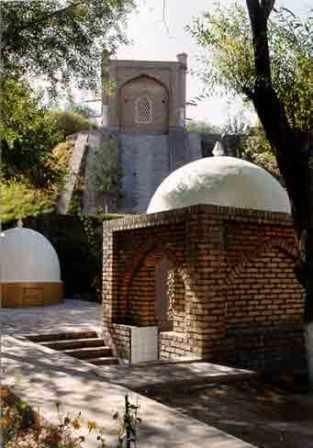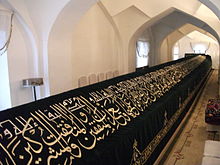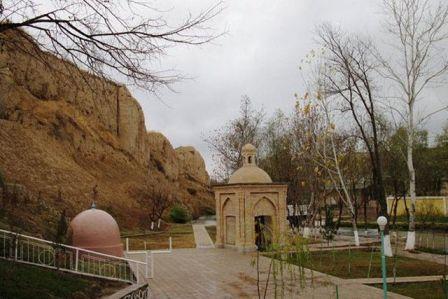|
Category
|
Mausoleum Doniyor-paygambar (prophet Daniel)
The prophet Daniel is revered by three world religions. He is one of the four great Israel prophets in Judaism, the prophet, whose book is included in the Old Testament of the Christian Bible, and the prophet in Islamic tradition. Daniyar Hodge (St.Daniel) was born in Jerusalem in 603 BC and descended from the kings David and Solomon. When Israel in 586 BC was captured by the king of Babylon Novuhudonosor, Daniel was taken to Babylon, along with other young men of noble birth. There's 15-year-old Daniel along with his three friends after a special school identified in the service at the royal court. Here he remained at the rank of court dignitary during the whole reign of Novuhudonosor and his five successors. After the conquest of Babylon by the Persians, he became an adviser to kings Darius and Cyrus. God gave Daniel the ability to understand the importance of visions and dreams, and this ability he showed and explained Novuhudonosor two his dream, which greatly embarrassed the king. In his book, the prophet Daniel recorded several prophetic visions concerning the end of the world and the second coming of Christ. In terms of the content of his prophetic book, which consists of 14 chapters, has much in common with the revelation of Evangelist St. John. During the reign of Darius, when Daniel took an important government post, envious of the number of pagan lords slandered him before Darius and made to Daniel was thrown to the lions. But God has preserved the prophet unharmed. Having examined the matter, Darius ordered Daniel's detractors throw the same penalty, and the lions immediately devoured them. A bit later, Daniel received a revelation of the 70 sevens, which indicated the first coming of the Messiah and the grounds of his kingdom.
Being already at an advanced age Daniel answered the king with a request to let him go on vacation. He then moved to Susa (modern Shush city in Iran), where he died and was buried in the royal tomb. According to legend, Amir Temur in his next seven-year campaign in Asia Minor (1397-1404 gg.) made a pilgrimage to the mausoleum of the saint and decided to move part of his remains to the capital of his empire - Samarkand. It is believed that Timur carried his hand holy. According to legend, when a caravan consisting of fifty camels approached the capital, they stopped on the bank of the Siab river, where now there is a mausoleum, a horse, carrying the remains, stood on this site and did not want to move on. The blow of its hoof suddenly scored a healing spring. Then Timur ordered the relics of the saint buried here, especially since this place was very similar to burial at Susa. Above the burial place of the Mausoleum was built. Then, years later, the tomb of a sudden started to grow, reaching a length of 17 meters. In this regard, in the past, his tomb was completed and lengthened periodically, at the beginning of XX century over the burial of the holy mausoleum was built with a chain of domes.
The place is an object of pilgrimage for both local residents and visitors from around the world. In 1996, arrived in Samarkand, the late Russian Patriarch Alexy II visited the mausoleum, and hallowed it. It is said that after the consecration, close the mausoleum again blossom pistachio tree, which was considered dead. A curious fact - many pilgrims who arrived in this holy to Islam, Judaism and Christianity, the place is also used Zoroastrian tradition - turn in prayer to the Holy One and the remains of cloth tied to the growing trees. In preparing the articles used material sites http://www.e-samarkand.narod.ru, http://sam-mus.uz and www.samarkand-foto.ru |
 Mausoleum Doniyor-paygambar or Doniyor Hodge (St.Daniel) is one of the most famous places of worship in Samarkand. With the same reverence to it are Muslims, Christians and Jews. Doniyor, Daniil, Daniel - the names of the same saint in the Muslim, Christian and Judaic religions.
Mausoleum Doniyor-paygambar or Doniyor Hodge (St.Daniel) is one of the most famous places of worship in Samarkand. With the same reverence to it are Muslims, Christians and Jews. Doniyor, Daniil, Daniel - the names of the same saint in the Muslim, Christian and Judaic religions. In the reign of Cyrus Daniel sat in the same rank at court. It is not without its participation in the year 536, King Cyrus issued a decree to release the Jews from captivity. According to legend, the prophet Daniel showed Cyrus prophecy about him in the book of Isaiah, who lived two hundred years before. Struck by this prophecy, the king commanded the Jews to build a temple in his honor in Jerusalem. At the same time the king was again saved from the death that threatened him for killing the dragon, which deifies the Gentiles.
In the reign of Cyrus Daniel sat in the same rank at court. It is not without its participation in the year 536, King Cyrus issued a decree to release the Jews from captivity. According to legend, the prophet Daniel showed Cyrus prophecy about him in the book of Isaiah, who lived two hundred years before. Struck by this prophecy, the king commanded the Jews to build a temple in his honor in Jerusalem. At the same time the king was again saved from the death that threatened him for killing the dragon, which deifies the Gentiles. City residents for many centuries used water from the spring believing in its healing power. The place also wins its peace and beauty, especially in the warmer months, when a lot of greenery and a few meters from the source on the Siab river swim swans and ducks.
City residents for many centuries used water from the spring believing in its healing power. The place also wins its peace and beauty, especially in the warmer months, when a lot of greenery and a few meters from the source on the Siab river swim swans and ducks.














